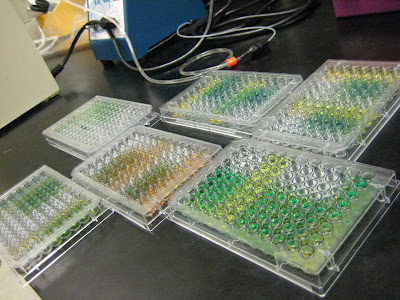Tuesday, July 27, 2010
Now We Can Be Bffls!
A few members of the MacQueen lab tentatively came into the Hingorani lab the other day to look at my microplates. In the microplates were fabulous colors (whose beauty was magnified by the photography skills of the MacQueen gang--see 'Sourjourn into Manjuland").
I am working on characterizing the kinetics of three MutS (Msh2-Msh6 in humans) mutants. MutS is a protein that recognizes mismatched DNA and recruits other proteins to initiate the DNA mismatch repair process. I am studying three cancer-associated mutants in Thermus aquaticus ("Taq"), as it is an easy organism to work with and there is high sequence homology between Taq and human MutS. In addition to binding mismatched DNA, MutS it is also an ATPase, and we're interested in the mechanism of ATP hydrolysis (ATP--> ADP + Pi) in the MutS mutants, and it is thought that MutS may communicate that it has bound a mismatch through coordination of its DNA binding site and ATPase domain.
One way to measure ATP hydrolysis is through phosphate production. The microplates that the MacQueeners photographed were part of the "Malachite Green Assay." Malachite green turns from yellow to green when it binds phosphate and this color change can be quantified. We create a standard curve with our stock of phosphate and then use this standard to calculate the concentration of phosphate at different time points in the reaction mixture that includes MutS and ATP. Using the concentration of phosphate at different time points in the reaction, we are able to determine kcat, which informs us about how fast the protein hydrolyzes ATP (more formally, kcat represents how many molecules of ATP are hydrolyzed per MutS active site per minute).
So there we go. Those are the pretty colors.
Sarah, now can we be best friends?
Saturday, July 24, 2010
On WEAST- Edit
Sojourns in Manjuland



On WEAST

Friday, July 23, 2010
Things that need to be addressed...
Thursday, July 22, 2010
5k citizens FUN run!!
Yesterday Amy and I ran a 5k race in middletown with some other MB&B students and faculty so Sarah asked me to blog about it.
It looked like it was going to rain during the race but miraculously, the storm stopped just for the race. The weather was perfect for the race. The race was about three miles long and it looped around william street/college street and around washington terrace/usdan. After the race we all met up to take a picture and to eat pizza, bagels and cookies.
 CONGRATS TO PROFESSOR HOLMES AND ARIEL FOR PLACING IN THEIR AGE GROUPS!!!
CONGRATS TO PROFESSOR HOLMES AND ARIEL FOR PLACING IN THEIR AGE GROUPS!!!
The Wesleyan MB&B team also place fifth overall :) yay for us!!!
Overall the race was really fun and I hope that more people from our lab will participate next time
goodbye for now
Shmoo you.

Everybody loves science.....even Public Safety
Alright, so after much poking and prodding by Sarah and Tatiana…and then reading something about tears (see entry below), I have decided to make my first contribution to the blog. Bear with me.
So last week, while sitting at my job in the Science Library and doing my daily tasks (twiddling my thumbs, watching an episode of Felicity, spinning in the chair, etc.), a bored Public Safety officer strolled up to the counter and stared at me until I finally agreed to look up and make conversation. After talking about random things like the weather, Lebron James, Pattie Palace, and how he was a court martial (and not an employee at Marshalls like I originally thought he said), we somehow came upon the topic of how I was a Bio major that was working in a lab this summer. Upon hearing that, the excitement could not have been more evident on his face.
Excited Public Safety Officer: Do you guys work with mice?
Me: No, we work with yeast.
Until I said that of course.
Even so, he continued to go on and on about how he watched something on television that showed scientists growing a human ear on a mouse, and how crazy and exciting the idea was, and how amazed he was, and how he never thought such a thing was possible….and so on and so
forth. And of course, being in the field that I am, I could not help but not only feel the same excitement as the officer, but also the urge to learn more about what he was talking about (see here: http://news.bbc.co.uk/2/hi/health/1949073.stm).
But in addition to this, the conversation with the officer had me thinking. I could care less about math or history. I couldn’t initiate a conversation with anyone on a topic of interest in economics, philosophy, or religion. But everyone…yes everyone, loves at least some aspect of science.
Even if it’s just Bill Nye the Science Guy, because everyone loves him too.
Good night.
I'm going to replica plate my TEARS now!!!!!!!!!!!

Wednesday, July 21, 2010
WHAT UP CELL CULTURE!!!!!!!!!!!!!!!!!!!!!!!!!
 Greetings from Fuzzy (and Jr), our lab contamination pet.
Greetings from Fuzzy (and Jr), our lab contamination pet. 
